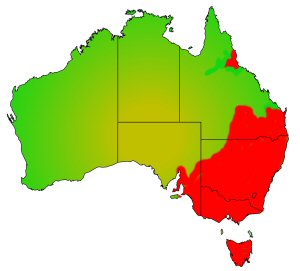Australian glass shrimp facts for kids
Quick facts for kids Australian glass shrimp |
|
|---|---|
| Conservation status | |
| Scientific classification | |
| Genus: |
Paratya
|
| Species: |
australiensis
|
Paratya australiensis, also known as the Australian glass shrimp or freshwater shrimp, is a tiny creature found in fresh water across southeastern Australia. It's a type of crustacean, like a crab or a lobster, and belongs to a group called decapods because it has ten legs.
Contents
What do Australian Glass Shrimp Look Like?
Australian glass shrimp have bodies that are mostly see-through. They might have some spots or patches, but you can often see right through them! They look a lot like other shrimp you might have seen.
These shrimp are called "decapods" because they have five pairs of legs, which means ten legs in total. They also have special hair-like bristles, called setae, on their "fingers." They use these bristles to help them eat.
Most of these shrimp grow to about 3 centimeters (1.2 inches) long. The biggest ones can reach up to 4 centimeters (1.6 inches).
Where do Australian Glass Shrimp Live?
Australian glass shrimp are found in many freshwater places across southeastern Australia. You can find them from central Queensland down to southeastern South Australia. This includes most of New South Wales, all of the Australian Capital Territory, Victoria, and Tasmania. They are not found on the islands in the Bass Strait.
What is the Habitat of Glass Shrimp?
These shrimp mostly live in water that is slow-moving or still. This includes places like lakes, ponds, rivers, creeks, and streams in low-lying areas. They can even be found in parts of estuaries where the water is a little salty.
You will usually find them among water plants, especially near the edges of these water bodies.
How do Australian Glass Shrimp Live and Reproduce?
Most Paratya shrimp live for about two years. The female shrimp carry their eggs under their tails during August and September. The tiny shrimp hatch in late spring to early summer.
When they first hatch, the young shrimp are free-swimming. During summer, river flows are usually at their lowest. This helps the tiny, free-swimming young, called planktonic larvae, from being washed out to sea.
Most of these shrimp live along the edges of streams where the water moves very slowly or not at all. They mainly eat algae and small bits of dead plants or animals. They scrape this food from the bottom of the stream using the bristles on their "fingers."
Are Australian Glass Shrimp Protected?
The Australian glass shrimp is listed as "least concern." This means that there are plenty of them, and they are not currently at risk of disappearing.
How are Glass Shrimp Used by Humans?
Australian glass shrimp are often used by people who fish in freshwater. They are a popular type of bait. People catch them using small dip nets or special box traps designed for bait.
These shrimp are also used as live food for larger pet fish in aquariums. Some people even keep them as pets in their own aquariums, either by themselves or with smaller fish.



